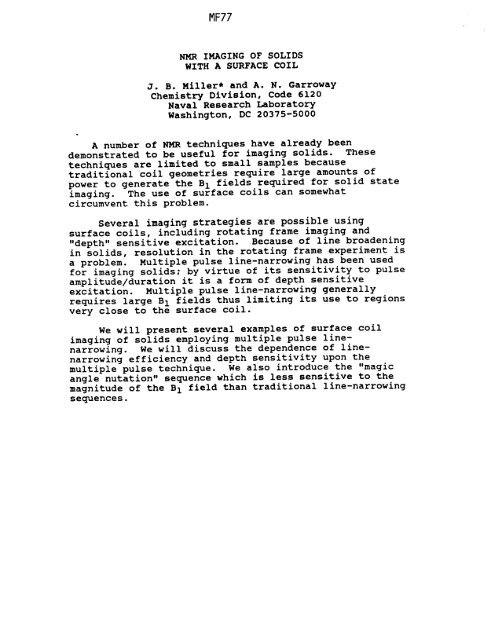th - 1987 - 51st ENC Conference
th - 1987 - 51st ENC Conference
th - 1987 - 51st ENC Conference
Create successful ePaper yourself
Turn your PDF publications into a flip-book with our unique Google optimized e-Paper software.
MF77<br />
NMR IMAGING OF SOLIDS<br />
WITH A SURFACE COIL<br />
J. B. Miller* and A. N. Garroway<br />
Chemistry Division, Code 6120<br />
Naval Research Laboratory<br />
Washington, DC 20375-5000<br />
A number of NMR techniques have already been<br />
demonstrated to be useful for imaging solids. These<br />
techniques are limited to small samples because<br />
traditional coil geometries require large amounts of<br />
power to generate <strong>th</strong>e B 1 fields required for solid state<br />
imaging. The use of surface coils can somewhat<br />
circumvent <strong>th</strong>is problem.<br />
Several imaging strategies are possible using<br />
surface coils, including rotating frame imaging and<br />
"dep<strong>th</strong>" sensitive excitation. Because of line broadening<br />
in solids, resolution in <strong>th</strong>e rotating frame experiment is<br />
a problem. Multiple pulse line-narrowing has been used<br />
for imaging solids; by virtue of its sensitivity to pulse<br />
amplitude/duration it is a form of dep<strong>th</strong> sensitive<br />
excitation. Multiple pulse line-narrowing generally<br />
requires large B 1 fields <strong>th</strong>us limiting its use to regions<br />
very close to <strong>th</strong>e surface coil.<br />
We will present several examples of surface coil<br />
imaging of solids employing multiple pulse line-<br />
narrowing. We will discuss <strong>th</strong>e dependence of line-<br />
narrowing efficiency and dep<strong>th</strong> sensitivity upon <strong>th</strong>e<br />
multiple pulse technique. We also introduce <strong>th</strong>e "magic<br />
angle nutation" sequence which is less sensitive to <strong>th</strong>e<br />
magnitude of <strong>th</strong>e B 1 field <strong>th</strong>an traditional line-narrowing<br />
sequences.













